#us fish and wildlife service
Text
The U.S. Fish and Wildlife Service last week withdrew much-needed draft migratory bird protection rules the agency promised to propose two years ago. These rules are necessary to protect migratory birds from being killed by preventable hazards, including by window collisions, like October’s massive bird mortality event at McCormick Place in Chicago.
“It’s nonsensical that after two years of delay, the Fish and Wildlife Service withdrew these proposed protections with the threadbare excuse that even more delay is needed,” said Tara Zuardo, a senior advocate at the Center for Biological Diversity. “Yet despite the lack of regulations, this agency still has the power to levy fines against parties that cause the death of birds, and federal officials should use their authority to do so.”
Under the Trump administration, the Service finalized a rule that upended decades of enforcement of the Migratory Bird Treaty Act. This radical and unlawful reinterpretation concluded the law did not prohibit the unintentional killing of migratory birds.
In response to successful litigation by the Center and allies, the Biden administration revoked this rule in 2021. The agency promised to issue regulations to address situations like what happened at McCormick Place, where infrastructure is known to cause bird deaths.
However, after two years of delay, the agency withdrew its own proposed regulations, claiming that it requires an indefinite amount of time to work on the rulemaking. This leaves billions of birds vulnerable to increasing threats across the landscape like collisions with windows and communication towers.
#ecology#enviromentalism#migratorybirds#bird conservation#US Fish and Wildlife Service#wildlife services#Fuck wildlife services
21 notes
·
View notes
Text
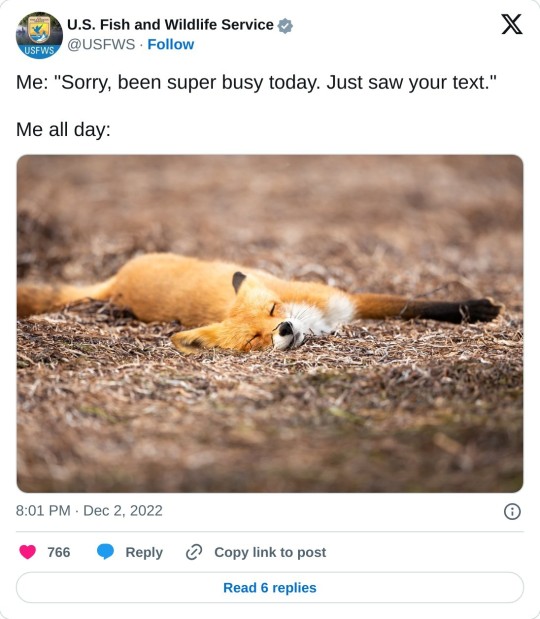
#img#described in alt text#twitter#foxes#usfws#us fish and wildlife service#reposting this so there’ll be a version with alt text & a proper source link
21 notes
·
View notes
Text

Someone counted Tick Georg
99 notes
·
View notes
Text
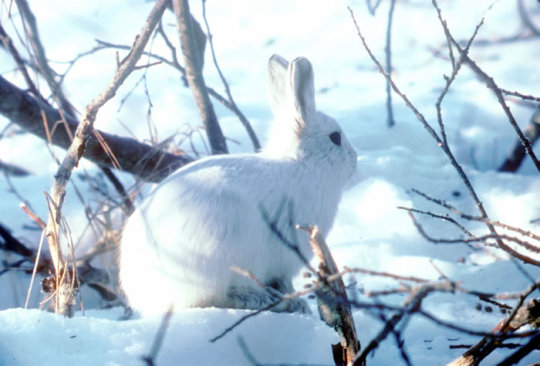
The Arctic hare lives in the tundra and in rocky mountainous areas. It needs places with enough cover to let plants grow and keep snow from getting too deep.
Source: nhpbs.org
#archive#archiving#web archive#arctic#arctic hare#hare#rabbit#animals#snow#us fish and wildlife service#pbs
35 notes
·
View notes
Text
What does the US fish and wildlife service actually DO?!
2 notes
·
View notes
Text

EAT THE CARP poster, 1911. Records of the US Fish and Wildlife Service, NARA ID 5710027. Featured in the National Archives exhibit “What’s Cooking Uncle Sam.”
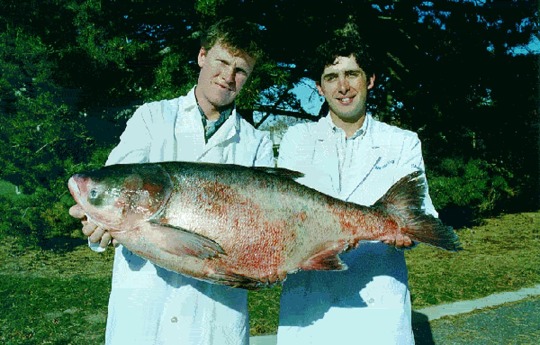
Two students hold a bighead carp. Illinois Waterway; Mississippi River; Great Lakes. undated. Records of the US Fish and Wildlife Service, NARA ID 166698952.
EAT THE CARP!
Good for gefilte fish... and more!
By Miriam Kleiman, Public Affairs
The US Fish and Wildlife Service's creative and innovative outreach dates back more than a century, as shown in this 1911 "EAT THE CARP!" poster imploring Americans to embrace, fish, and eat the heavily proliferating carp. The poster is a brilliant appeal to turn of the century foodies! (NARA holds millions of records from the U.S. Fish and Wildlife Service, Record Group 22, dating back to 1868!)
"Catch the carp; buy the carp, cook the carp properly and eat it. Eat the roe; can the roe. Make carp jelly. Can the fish. Smoke it too."
Need more encouragement? Carp: something for everyone!
For keto fans: "This meat is wholesome and nutritious. It contains as much protein as sirloin steak."
Got GI issues? "It is easily digestible."
For followers - join the pack! "Somebody ate the 43,000,000 pounds of carp. Therefore the carp must be good to eat."

EAT ME! Original caption: "This fish is in trouble. A Big Muddy National Wildlife Refuge (MO) employee holds an Asian carp, (Invasive species), for the camera." Records of the US Fish and Wildlife Service, NARA ID 166692514.
More CARP records!
"It's summertime and the living is easy. Fish are jumping..." (George Gershwin, Porgy and Bess )

These Big Muddy National Wildlife Refuge (MO) employees electrofish for the Asian carp, undated, Records of the US Fish and Wildlife Service, NARA ID 166692518.
"Tree Catches Fish"
"This Asian carp, (Invasive species), jumps up to the trees to escape the long arm of the biologists."

Big Muddy National Wildlife Refuge (MO), undated. Records of the US Fish and Wildlife Service, NARA ID 166692522.

Boy and Carp, Department of the Interior. Bureau of Indian Affairs. Pine Ridge Agency, undated. NARA ID 12459787.
Don't forget the gefilte fish!

Dancing gefilte fish gif online here.
More online!
“A Carpapalooza: An American Anthem”, Pieces of History
Learn about the dangers of illegal muskrat trapping!
Fur Warden Sketches Map of Fortymile River Basin in Alaska, The Text Message.
National Park Service Virtual Tour, National Archives Catalog newsletter.
#usfws#nature#environment#fishing#i love fish#angler#carp#wildlifephotography#lures#fishing life#usinterior#wildlife refuge#fishingtrip#gefilte fish#native american#indigineous people#us fish and wildlife service
77 notes
·
View notes
Photo

13 notes
·
View notes
Photo
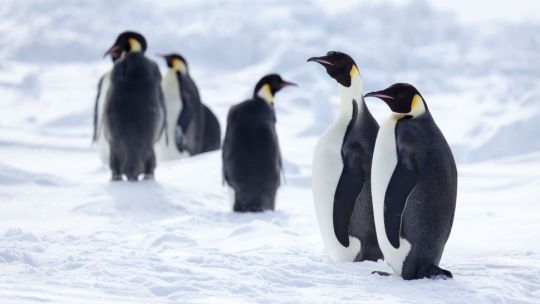
A group of six emperor penguins standing on the ice. U.S. Fish & Wildlife Service announced a proposal to list the emperor penguin as threatened under the Endanger Species Act (ESA).
(Image credit: Peter Kimball @ Woods Hole Oceanographic Institution)

#peter kimball#photographer#emperor penguins#penguins#bird photography#us fish and wildlife service#endangered species act#woods hole oceanographic institution#nature
8 notes
·
View notes
Text

Bald Eagles (February 1, 1979)
Alternative Title: Haliaeetus leucocephalus.
Creator: U.S. Fish and Wildlife Service.
Description: Bald eagles on snowy river bank.
Subjects: Birds; Eagles; Raptors; Birds of prey.
Publisher: U.S. Fish and Wildlife Service.
The creator compiled or maintained the parent series, Photographs from the National Digital Library, between ca. 1998–2011.
Record Group 22: Records of the U.S. Fish and Wildlife Service
National Archives Catalog
2 notes
·
View notes
Text
A pair of conservation coalitions on Monday made good on their threats to sue the U.S. government over its denial of federal protections for gray wolves in the northern Rocky Mountains, where state killing regimes "put wolves at obvious risk of extinction in the foreseeable future."
The organizations filed notices of their plans for the lawsuits in early February, after the U.S. Fish and Wildlife Service (FWS) determined that Endangered Species Act protections for the region's wolves were "not warranted." The Interior Department agency could have prevented the suits in the U.S. District Court for the District of Montana by reversing its decision within 60 days but refused to do so.
"The Biden administration and its Fish and Wildlife Service are complicit in the horrific war on wolves being waged by the states of Idaho, Wyoming, and Montana," declared George Nickas, executive director of Wilderness Watch, one of 10 organizations represented by the Western Environmental Law Center (WELC).
"Idaho is fighting to open airstrips all over the backcountry, including in designated Wilderness, to get more hunters to wipe out wolves in their most remote hideouts," Nickas noted. "Montana is resorting to night hunting and shooting over bait and Wyoming has simply declared an open season."
Brooks Fahy, executive director of Predator Defense, another WELC group, pointed out that "these states are destroying wolf families in the Northern Rockies and cruelly driving them to functional extinction via bounties, wanton shooting, trapping, snaring, even running over them with snowmobiles. They have clearly demonstrated they are incapable of managing wolves, only of killing them."
KC York, founder and president of Trap Free Montana, also represented by WELC, said that "Montana, Idaho, and Wyoming know that they were let off the hook in their brutal and unethical destruction of wolves even acknowledged as such by the service."
"They set the stage for other states to follow," York warned. "We are already witnessing the disturbing onset of giving the fox the key to the hen house and abandoning the farm. The maltreatment is now destined to worsen for these wolves and other indiscriminate species, through overt, deceptive, well-orchestrated, secretive, and legal actions."
The other organizations in the WELC coalition are Alliance for the Wild Rockies, Friends of the Clearwater, International Wildlife Coexistence Network, Nimiipuu Protecting Our Environment, Protect the Wolves, Western Watersheds Project, and WildEarth Guardians.
The second lawsuit is spearheaded by the Center for Biological Diversity, Humane Society of the United States, Humane Society Legislative Fund, and Sierra Club, whose leaders took aim at the same three states for their wolf-killing schemes.
"The states of Montana, Idaho, and Wyoming act like it's 1880 with the most radical and unethical methods to kill as many wolves as possible in an effort to manage for bare minimum numbers," said Sierra Club northern Rockies field organizer Nick Gevock. "This kind of 'management' is disgraceful, it's unnecessary, and it sets back wolf conservation decades, and the American people are not going to stand by and allow it to happen."
Margie Robinson, staff attorney for wildlife at the Humane Society of the United States, stressed that "under the Endangered Species Act, the U.S. Fish and Wildlife Service cannot ignore crucial scientific findings. Rather than allow states to cater to trophy hunters, trappers, and ranchers, the agency must ensure the preservation of wolves—who are vital to ensuring healthy ecosystems—for generations to come."
The Center for Biological Diversity's carnivore conservation program director, Collette Adkins, was optimistic about her coalition's chances based on previous legal battles, saying that "we're back in court to save the wolves and we'll win again."
"The Fish and Wildlife Service is thumbing its nose at the Endangered Species Act and letting wolf-hating states sabotage decades of recovery efforts," Adkins added. "It's heartbreaking and it has to stop."
#ecology#enviromentalism#biden administration#us politics#let wolves live#wolves#endangered species act#us fish and wildlife service#wildlife services#wildlife#Fuck Wildlife Services#montana#idaho#wyoming#department of the interior#center for biological diversity
3 notes
·
View notes
Text

3K notes
·
View notes
Text
there are so many wildlife jobs!!!
I graduate in one year and it’s overwhelming how much I want to try!!!
#wildlife#wildlife conservation#herpetology#fish hatcheries#stream surveys#oh on and so on!#I currently do some work as an intern doing stream surveys#it's a lot of hard rough work but I wouldn't have it any other way#Us forest service is a really great place to work!#lots of nice accepting people
2 notes
·
View notes
Text
ok this sounds insane but in 2018 i went to a few carnivorous plant talks at the botany conference in minnesota. i got caught up in conversation with one of the guys there who was a huge nepenthes guy who told me a story about another collector in the pacific northwest who'd been buying poached plants, like a huge amount, and eventually got staked out by the fish and wildlife service and arrested and had all his plants seized and went to prison for it. idk if i ever talked about this on this blog before-- i know i liveblogged a lot from that conference but cant remember what all i posted-- but ive avoided talking about it since then because i was never able to find like, news articles or anything covering it, but behold.... we now have proof it was real, and im like 80% sure this was this guy he was talking about. the raid happened in 2016 and they'd been staking them out since 2013. he had nearly 400 plants and had been sourcing many of them from poachers in indonesia and borneo.
remember folks: poaching happens with plants too! it's a huge problem not only in carnvirous plants (nepenthes especially, which this piece is dedicated to talking about) but also in native plant populations in the US, including native carnivorous plant populations (north and south carolina's venus fly traps, california's darlingtonia, and sarracenia from the east coast), native orchids (historically one of the most poached categories), desert plants/cacti/succulents, and slow-growing woody ornamentals (cycads, for example). never buy bare-root plants off ebay or facebook! your best bet is local nurseries (which usually purchase farm-raised plants that do well in a wide range of conditions, and as a result have a healthy population in the wild) or specialty greenhouses (more expensive, but at least in the case of carnivorous plants offer young plants bred from established adult plants in-house, raised in captivity).
#super sad piece fellas like this shit guts me i cant even stress it enough#stories about nepenthes poaching hit different#there are hundreds of species#some are really common and widespread all over indonesia/china/japan/oceania#and some are like. super hyperadapted to one specific ridge on one specific mountain#theyre still being recorded and stuff because theyve speciated so much#so youll have a plant that has like. a max of 15 adults in the population at any given time. literally a nightmare scenario#AND theyre diaceous (there are male plants and female plants). doesnt seem like a problem until you think about the population dynamics#there not only has to be two plants but the plants have to be a male and a female#and people living there have reason to take them. like the poacher interviewed in this article does it to supplement his income#from working at a horrifying rubber production ordeal to feed his wife and kids#and he says everyone in his village does the same for the same reasons#nightmare!! nightmare!! nightmare horrible nightmare world!!! horrible fucking nightmare!!!!#nepenethes#carnivorous plants#poaching#conservation
11K notes
·
View notes
Text
So, I saw a post circulating here about the “extinction of birds in 2023“, with this picture attached
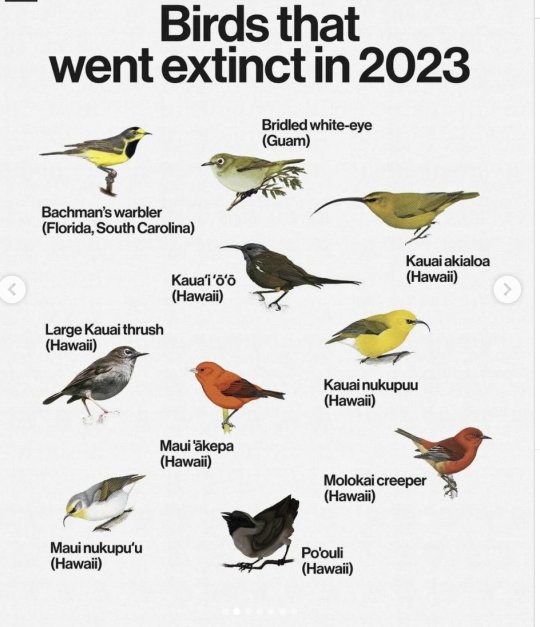
My, what a bold claim! All these poor birdies, “went extinct” in just one year alone? Why would such an outrageous, depressing and catchy claim be spread around?
Let’s fact check it.
All the species listed, Bachman’s wabler (Vermivora bachmanii, 1988 or 1980s), Kāmaʻo or large Kauaʻi thrush (Myadestes myadestinus, 1989 or 1987), Bridled white-eye (Zosterops conspicillatus, 1983 and 1983), Kauai ʻakialoa (Akialoa stejnegeri, 1969 or 1960s), Kauaʻi ʻōʻō (Moho braccatus, 1987 and 1987), Kauaʻi nukupuʻu (Hemignathus hanapepe, 1899 and 1899), Maui ʻakepa (Loxops ochraceus, 1988 and 1988), Kākāwahie or Molokaʻi creeper (Paroreomyza flammea, 1963 and 1963), Maui nukupuʻu (Hemignathus affinis, 1896* and 1996 ) and Poʻouli (Melamprosops phaeosoma, 2004 and 2004) are all, indeed, either extinct or possibly extinct, according to IUCN Red List of Threatened Species and U.S. Fish and Wildlife Service.
What are the dates after the scientific names? Well, those all are *last sightings* per IUCN Red List and USFWS accordingly. So, these birds were not seen for DECADES and in one case FOR MORE THAN A GODDAMN CENTURY. And sure as hell there is NO information about them very suddenly being gone all last year.
What’s the deal then? Where did this claim even come from? Well, likely from this article "21 Species Delisted from the Endangered Species Act due to Extinction" from U.S. Fish & Wildlife Service. It includes all the birds in the picture (with the last date of sight, listed above).
From the article: “The U.S. Fish and Wildlife Service is delisting 21 species from the Endangered Species Act due to extinction. Based on rigorous reviews of the best available science for each of these species, the Service determined these species are extinct and should be removed from the list of species protected under the ESA. Most of these species were listed under the ESA in the 1970s and 80s and were in very low numbers or likely already extinct at the time of listing.”
They didn’t ALL fucking suddenly drop dead all in the same year – if they did, as some other people have already pointed out, there would be an uproar EVERYWHERE. Ornithologists alone would not let it live down. They were officially delisted from endangered status by U.S. Fish & Wildlife Service that year, there was a proposition to do so back in 2021, too. Some were already declared extinct before by IUCN.
Despite not being seen for so long, they remained on the list of critically endangered for a long while, cause you cannot just immediately declare a species extinct. There’s no RTS unit amount number that goes to 0 once there’s nothing left; people keep checking for them over and over and over again. Sometimes it turns out that a species previously thought to be extinct is actually still out there. Attenborough's long-beaked echidna for example was last sighted SIXTY YEARS ago before being sighted again in 2023. It was thought to be extinct for a while, before 2007, when signs of its activity was spotted again. More often than not though, a species turns out to be actually very extinct, unfortunately – like in this case.
I cannot possibly know if the creators of this picture, or people that spread it on social media ever had good intentions behind it for awareness, however even if they did, it turned out to be nothing but very blatant misinformation, with a fearmongering effect. The only thing this achieves is not awareness of habitat destruction or pernicious tourist influence or climate change or what have you – the only thing this achieves is despair and panic. People already so casually fall into complete doomerism, they’re very used to hear bad news. And guess what doomerists do? Typically nothing. It renders people helpless. It’s not gonna make people get up and be ready for action, it, at best, would just make people feel sad and/or angry, or at worst, feed into the current alarming rise of ecofascism. NOTHING good comes out of this. At the very goddamn least, no one needs to lie to promote a goal.
The aim of the USFWS article, on the other hand, IS to make people aware about those animals that are already gone from the face of the planet, no matter how long ago, and that now we have to protect those animals that are critically endangered and still out there – to not have to repeat those tragedies.
Be very critical of what you see on the internet, especially if it’s sited with no sources. Especially-especially if it causes a strong emotional reaction. Lies and misinfo could only hurt the cause, no matter how noble. And please, be aware of your local wildlife status. Check in with it accoding to trusted sources.
[*sic, possibly a typo and it was meant to be 1996, other confirmed date listed there is 1989]
Addendum: I could not for sure find the uncredided (who woulda thunken that ppl that don't cite their sources would also not credit the artists) author(s) of the bird illustrations. If someone finds them, please, let me know!
Edit: Huge thanks to moosefinch for finding the sources for the artwork! I'll add their contribution below:
"Image sources!
The Kauai ʻakialoa, Kauaʻi ʻōʻō, Maui ʻakepa and Kauaʻi nukupuʻu are from Birds of the World.
The "Maui nukupuʻu" and "Molokaʻi creeper" illustrations are also Birds of the World, but are actually a female Kauaʻi nukupuʻu (the other being the male) and Laysan honeycreeper/Laysan ʻapapane respectively.
The bridled white-eye is by Lauren Helton according to this source.
Bachman's warbler is by Lynn Hawkinson Smith/smithhouse2 according to this Etsy listing.
The Poʻouli is by Christina Czajkowski."
#ah I just now see that the tumblr reblog of the pic and the twitter thread attached was deleted#yet the post is still in circulation. The damage lingers#so fucking irresponsible#fact check#misinformation#birds#bird#ecology#environmentalism#extinction#conservation#species conservation#animals#hawaiʻi#important
803 notes
·
View notes
Note
Do you have any magpie pics and fun facts? Magpies are my favorite birds of all time - i love me a tuxedo crow
Here in the United States if you want to see a magpie, you've got to head out west, and this is one of my favorite western birds.
Most of you probably know that magpies, like other corvids are very intelligent, and get up to all kind of mischief. Some of you may know that Black-billed Magpies?particularly like to sit on larger animals, where they survey for small prey, disturbed by the larger animal's hooves, as well as feeding on parasites that may be on the animal.

Black-billed Magpies (Pica hudsonia), family Corvidae, order Passeriformes, western USA
Photographs via: US Fish & Wildlife Department and the National Park Service 

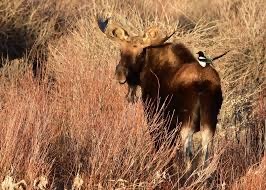


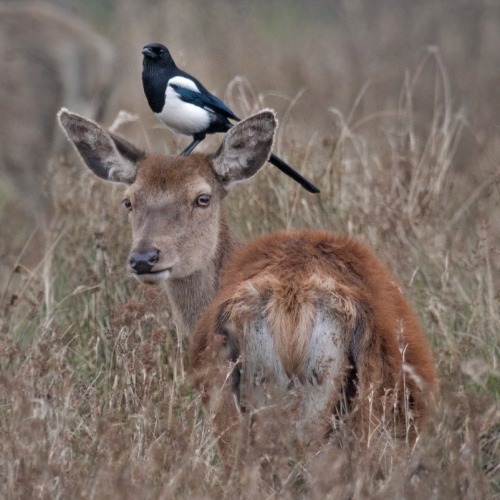


629 notes
·
View notes